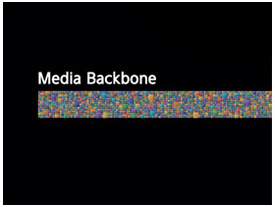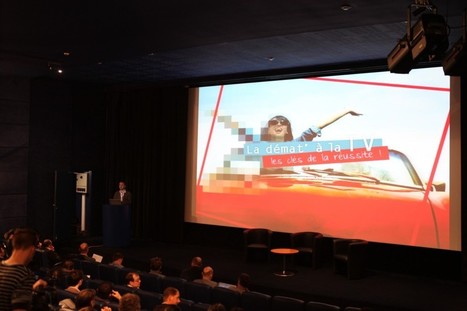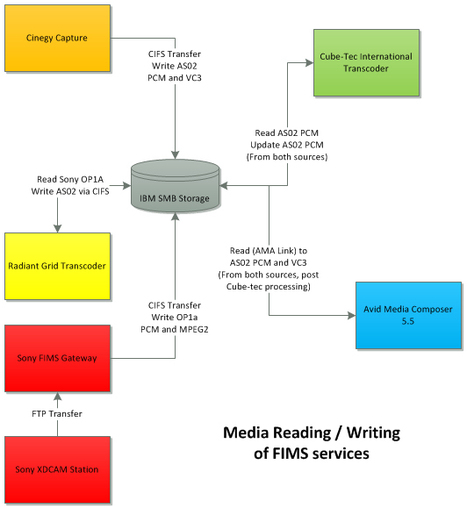 Your new post is loading...
 Your new post is loading...
The reign of end-to-end OTT platforms is over, here comes the modular OTT Platform ! With SOA, FIMS, IMF and DASH, agility time has (almost) come... This is the report/sequel of Vimond's Industry Visionaries IBC2013 talk about “The Future of OTT Platforms: Is it Diversification or Standardization ?” with Eric Schumacher-Rasmussen, Editor of Streaming Media Magazine, and Nicolas Weil.
What has business process management got to do with broadcasting? Surely, it is more relevant to a manufacturing operation; broadcasting is a creative business, isn’t it? Sure, production is creative, but to an outsider, broadcasting operations are much like manufacturing. Raw materials — the program tape or file — arrive from the production company, and at the other end, the broadcaster delivers programs to the viewer. Through all the many processes, the program has been formatted for the viewer’s television, tablet or smartphone, and any necessary subtitles, captions or dubbed audio have been added to the program. The channel schedule has been delivered to the third-party listings guides with information about each program, and the promotions department may also have created trailers for the program. Is this not a manufacturing operation, a media factory? Over the last decade, many verticals outside the media-and-entertainment sector have moved to a software architecture where the processes are managed as a whole, rather than using islands of software to process the product. This holistic management of business processes potentially offers a more efficient way to command, control and optimize media operations.
SOA-based archiving process for News - proof of concept (IRT study)
The concept of service-oriented architecture (SOA) is currently being introduced in professional broadcast environments. It offers, in principle, a more effective way of integrating systems in a production platform.
This article illustrates the concept of SOA and describes an actual implementation that has been used in a proof-of-concept study. This study demonstrated the archiving of news as an integrated end-to-end process. The experience gained gives an insight into where, as an integration platform, the benefits of service-oriented architecture lie ... and also where specific challenges might arise.
READ PAPER HERE : http://tech.ebu.ch/docs/techreview/trev_2012-Q2_SOA_archiving_Elser.pdf
Live slow motion expert EVS will unveil its latest toolset for media exchange and file mastering at NAB. The Media Toolset can be used to streamline any broadcast and media workflow operations including the new version of the OpenCube server. OpenCube server combines the best of MXF file mastering technologies and advanced media conforming systems. The new generation of MXF file-based server is offering full mastering of AS02, AS03, and IMF formats, as required by Hollywood studios. Used to digitise the French National Archive (INA), the server’s a format-agnostic platform supporting all standard codecs on a full service-oriented architecture.
See product page : http://opencubetech.com/rub12/VIDEO%20IT%20Servers
At the turn of the month, at the European Broadcast Union (EBU) Production Technology Seminar in Geneva, European broadcasters will be urged to change their approach to production in order to reach a wider variety of platforms and, at the same time, cut energy consumption. The three-day seminar is designed to provide the 70 participants representing European broadcasters with the technical knowledge require to reconcile these conflicting goals and share experiences across all aspects of production. The headline themes of expanding reach and greenness will be covered in two keynotes, starting with Roberto Pomari, head of business development at RSI, the Italian speaking division of the Swiss public broadcaster. Pomari’s theme, how to become “tomorrow’s broadcaster,” will be based on RSI’s experience of moving to full HD production in the first months of this year, and developing a Service Oriented Architecture-based production platform as the next step in its digital evolution.
Broadcasters no longer have the monopoly on the delivery of A/V entertainment to the home. In the fiercely competitive world of media and entertainment, companies have to deliver more versions and formats, but without increasing their costs. A channel is now expected to have a Web presence, as well as mobile and tablet versions of their content.
Organizations like the EBU and Advanced Media Workflow Association (AMWA) are promoting the service-oriented architecture (SOA) as a route to provide the interoperable media services that can serve the new business requirements.
For the seasoned video engineer, the world of SOA introduces terms and concepts that at first encounter seem foreign and more suited to the IT specialist. As video processing migrates to the file domain, there is no option but to become familiar with what at first sight may appear alien.
Broadcast systems have evolved around the imposed workflow of the serial processing steps of videotape operations. Over time, many processes have moved from dedicated hardware boxes with SDI in and out to software applications on a network. A typical broadcast operation is now a hybrid of SDI and IP connections.
In many cases, the workflow remains as the original tape-based flow. Over time, other applications like asset and workflow management are layered over the entire process chain. The system has grown by accident, not by design, and become a web of custom or proprietary interfaces linking the many applications.
Sure it works, it was designed that way, but when the time comes to replace a component part — say the playout automation — the inflexibility of the system rapidly comes apparent. The parts of the system are linked by a web of custom APIs, often restricted to a specific release of a specific software application. It is just not possible to swap out the automation for the latest product without attending to the web of interfaces.
To meet the demands for new services to the public, the broadcaster must add facilities for a mobile news service, a 3-D channel and interaction with a social media website. Along comes CES and some new consumer device to consume content. How do you add support for this new device? Will it mean more custom interfaces or more special workflow applications? The EBU and AMWA are developing a Framework for Interoperable Media Services (FIMS), which aims to provide a new technology platform that leverages current IT practices, like the use of the SOA, to provide business agility and to control costs.
At the recent IBC Show in Amsterdam, numerous vendors were extolling the benefits of a service oriented architecture (SOA) for capturing, producing, processing and distributing video and audio content as digital files. It’s the latest industry buzz term, but this one appears to have staying power as it brings the potential cost- and resource-saving benefits for both customers and the manufacturers themselves. Although clearly interested, many attendees were left feeling a bit cautious about how to most effectively design and implement such an IT-centric system, even with the knowledge that it would increase efficiency and staff productivity while helping content providers manage the transition to a multi-screen, multi-format universe.
“Conductor” plays a key role in Sony's new Tapeless initiative called Media Backbone. Based on a Service Orientated Architecture (SOA) Media Backbone enables heterogeneous platforms and applications to be easily integrated and managed via a common Enterprise Service Bus (ESB). The benefits of an efficiently run, modular, scalable system are open-ended. A layered, abstracted system that can be viewed from a high level can be automated to an extreme degree, and integrated seamlessly with external services and consumers. Sony's experience with metadata-driven workflows is the key to integrating the proven benefits of SOA with a media production system.
Files are displacing videotape and film in acquisition and delivery. This raises the question ‘if we begin with files, post produce files and deliver files, why do we need conventional post and broadcast products? Can’t commodity IT kit do the job?’
The need has never been greater to get costs under control. Increasingly, commodity IT products can do the job -- but there’s growing evidence that to really drive down costs, we have to stop simply dropping IT-based products into conventional post and broadcast architectures and really start to think about business processes. That’s why Service Oriented Architecture (SOA) is now a hot topic. SOA is not a technology but rather a design philosophy widely used outside our industry, write Bruce Devlin and Mark Horton of AmberFin.
|
Le 17 octobre s’est tenu dans l’auditorium de Francetélévisions un Atelier Dig-it intitulé « Dématérialisation des contenus à la TV : les clés de la réussite ! » réunissant les meilleurs spécialistes français de la question, ainsi que plusieurs experts internationaux.
Content delivery network Limelight has added Opscode Hosted Chef to the Limelight Video Platform in order to provide automation to its service-oriented architecture (SOA). The chief benefit is that customers can use Hosted Chef to scale both data center and hybrid cloud infrastructure resources with one command. This lets customers prepare for demand spikes. Opscode is based in Seattle, Washington, and provides cloud infrastructure automation. It works with companies of all sizes to create scalable fully automated server infrastructures.
At this year’s NAB Show, Cinegy will launch Version 9.1 of its Cinegy Archive, Cinegy Desktop, and Cinegy Air and Type workflow solutions.Cinegy Archive now has a new open API with SOAP and REST web services that also form the basis of the new Cinegy Workspace Web client as well as its highly customizable portal front-end for cloud apps.
Cinegy Air and Type Version 9.1 now plays out up to 16 channels per server via SDI and/or IP-streams.It offers new features for automated and/or manual driven branding, and now supports MXF AS-03 and MXF AS-11.
Tying it All Together : A watershed moment in the Media Industry
Viewers have seen several step changes in the evolution of television, analog to digital, standard to high definition, and if you go back far enough, monochrome to color.
There have been similar changes on the production side, but those that have had most impact are the changes from film to videotape and analog to digital processing, the introduction of HD, and now the migration to file-based operations.
The migration from physical media to files processed on computer platforms presents opportunities and a new flexibility, but potentially adds complexity. You need systems that work together, and converting to file-based technology only gets you part of the way there.
Agreed file formats are necessary, but not sufficient to build digital facilities. To simplify file-based operations many media companies are adopting a service-oriented architecture. For the future the ‘cloud’ beckons, abstracting the services from geographical constraints.
The key to reusable services in the cloud lies in agreed standards and specifications that can enable interoperability.
READ THE PAPER HERE : http://www.amwa.tv/downloads/whitepapers/Tying_it_Together-Gilmer.pdf
VSN has announced it will attend CABSAT, Feb. 28 – March 1, in Dubai. Promoting its new generation of broadcast software solutions, the company will showcase new versions of its products in the areas of News Production, Content Management and Distribution and Advanced Graphics.
Included in the Spider platform, VSN’s new Workflow Manager allows full customization of a TV channel’s different workflows, thus generating a fully automated production operative. The seamless integration with VSNIPTRANSFER to work in a distributed environment (WAN), and the combination of Web architecture with Windows and Mac OS platforms, results in a powerful distributed, multiplatform ecosystem for the news production and the content management and distribution.
VSNNEWS now features a set of new functionalities including the system’s integration with different social networks such as Twitter and Facebook. Also, the SOA interfaces with MAM solutions. The proposed architecture is completely scalable as it grows, because most of services are now centralized and operated by “workers,” no matter the size of the system and the number of lo-res and hi-res clients involved.
Television news is, for a number of reasons, the most critical part of most broadcasters' operations. The way a broadcaster handles news is the clearest indication of its character, and the best way to create and manage a brand identity. Because of its very nature, it is a broadcaster's most complex operation, and working under intense pressure is an everyday norm. There is a long history of technology solutions to ease the production of television news — dating back 30 years to first-generation newsroom computer systems such as Basys and Newstar. Newsroom computer systems have dealt traditionally with words: wire services, scripts, running orders and research archives. More recently, a parallel stream of technology developed that handled the media assets: video clips, voice-overs and so on. The two computer networks are commonly linked, usually via a standard interface, which now is almost exclusively the Media Object Server (MOS) protocol. This production system manages ingest and live recording, moves content to editors and graphics workshops, compiles and delivers playlists, and hands completed content over to the archive. These two systems are both mission-critical for the news broadcast. Both are complex and both have heavy demands on processing and network traffic. But, operating them as two independent, albeit linked, systems seems wrong. Instead, the ideal solution must be to have one computer network that handles all the elements of news production. Put bluntly, such an architecture can be a nightmare to manage and maintain, and definitely not the path that should be taken in 2011. That said, let's look at a system that could very well be the answer broadcasters need.
Framework for Interoperable Media Services : FIMS White Paper [PDF]
Currently in the media industry, users are implementing service-based systems using proprietary systems with bespoke software ‘glue’ holding it all together. They are doing this without an open, agreed framework and without standardized interfaces. While several organizations have identified a number of common processes such as capture which are performed essentially the same way throughout the industry, users are implementing these processes as services in different ways. At the same time, technology vendors are responding to demand for services-based products, but interoperability between different implementations is non-existent. This is because there is a lack of an agreed framework and publically developed service definitions in the media industry. The AMWA-EBU FIMS (Framework for Interoperable Media Services) Task Force was established in December 2009. FIMS is a framework of service definitions for implementing media related operations using a Service-Oriented Architecture (SOA) approach. Media companies deploying this framework can expect that doing so will promote interoperability and reusability of services. FIMS defines service models with associated management, error handling, communication, and time awareness. To properly exploit this technology the Task Force has developed a common framework which will help ensure integration interoperability, interchangeability and reusability of services. This will drastically reduce integration costs, allow users to more freely choose the most appropriate products on the market at any given time, improve maintainability, and aid in the adoption of new technologies. FIMS also has begun the process of defining open services that are loosely coupled thereby enabling multivendor services to be integrated and creating “best-in-class” media systems. The services can span a wide domain of operations and permit integration of FIMS into business and management systems. The bottom line is that implementing FIMS will move facilities to an agile environment that is more easily configured, modified, managed and governed compared to non SOA systems. Read the full whitepaper here : http://wiki.amwa.tv/ebu/images/1/12/FIMS_WhitePaper_Version_1.0.1.pdf
The European Broadcast Union and Advanced Media Workflow Association will unveil the new SOA Framework for Interoperability of Media Services (FIMS) in TV Production at IBC 2011 in Amsterdam next month. The EBU did not want to repeat work already done and so decided to adopt a model for SOA first developed almost a decade ago by the IT industry standards body Oasis as the basis for its planned framework. Subsequently, the EBU then found that the Media Workflow Association (AMWA), which focuses on file-based workflows to benefit content creators including film, television, advertising, Internet and post-production professionals, was working along similar lines. The two bodies then joined forces to develop the Framework for Interoperability of Media Services (FIMS), which was announced at NAB 2011 in Las Vegas, but without details. Now the EBU and AMWA are ready to unveil FIMS 1.0, which will be demonstrated at the EBU Village near the IBC conference centre during the exhibition. The demonstration will show typical media services including capture, transfer and transcoding, with exchange of media files wrapped in the OP1a MXF (Material Exchange Format) versioning format.
The European Broadcasting Union (EBU) and the Advanced Media Workflow Association (AMEA) are to demonstrate some early capabilities of Service Orientated Media Workflows at this year's NAB show being held in Las Vegas in a little over one week's time. More info here : http://tech.ebu.ch/events/fims-nab11
|



 Your new post is loading...
Your new post is loading...

![[IBC 2013 Talk] The Future of OTT Platforms | Video Breakthroughs | Scoop.it](https://img.scoop.it/QcV918WTWh5B0iROqlVSxDl72eJkfbmt4t8yenImKBVvK0kTmF0xjctABnaLJIm9)













![Framework for Interoperable Media Services : FIMS White Paper [PDF] | Video Breakthroughs | Scoop.it](https://img.scoop.it/3wbB31kLNiKwnOisLmJzRTl72eJkfbmt4t8yenImKBVvK0kTmF0xjctABnaLJIm9)






